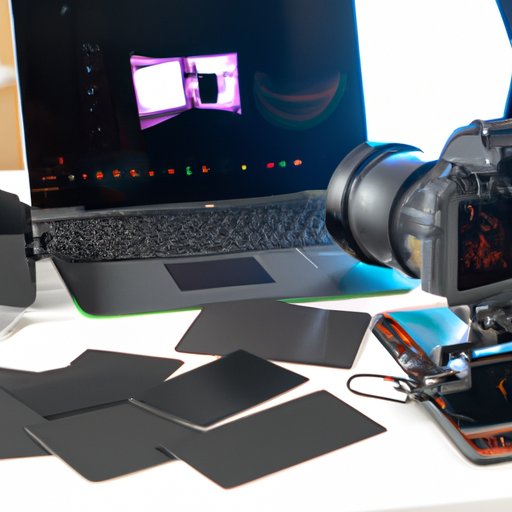
Introduction
Slow-motion videos have become increasingly popular in recent years, as they add a dramatic and emotional effect to storytelling. Whether you are a filmmaker, content creator, or social media enthusiast, mastering the art of slow-motion videos can give you a competitive edge and help you engage your audience. In this article, we will explore how to make video slow motion with video editing software, smartphones, and cameras. We will also discuss the benefits, common mistakes to avoid, and provide a beginner’s tutorial on creating slow-motion videos for social media platforms.
How to Turn Your Video into Slow Motion using Video Editing Software
The easiest and most effective way to turn your video into slow motion is to use video editing software. There are many video editing software options available, such as Adobe Premiere Pro, Final Cut Pro, iMovie, and Lightworks.
Here is a step-by-step guide on how to turn a video into slow motion using Adobe Premiere Pro:
- Import your video into the Adobe Premiere Pro timeline
- Select the clip you want to edit and right-click on it
- Choose “Speed/Duration” from the drop-down menu
- Select the percentage decrease in speed you want to apply to the clip
- Click on “OK”
- Your clip is now in slow motion. You can adjust the speed by dragging the clip edges on the timeline
It is important to note that when you slow down a video, it will also decrease its frame rate. This can result in choppy or blurry footage. To avoid this, you can shoot your video in a higher frame rate, such as 60fps or 120fps, and then slow it down in post-production. This will maintain the smoothness and clarity of the footage.
Shooting Slow Motion Video on Smartphone or Camera
Shooting slow-motion video on smartphones or cameras requires some technical knowledge, but it is a skill that can be easily acquired. The first step is to understand frame rate, which refers to the number of frames captured per second (fps). The higher the frame rate, the smoother the footage will be.
To shoot slow-motion video on a smartphone, you need to adjust the frame rate in the camera settings. For example, on an iPhone, you can go to “Settings” > “Camera” > “Record Video” and select the desired frame rate. Most smartphones offer frame rates up to 240fps, which is sufficient for most slow-motion videos.
When shooting slow-motion video on a camera, such as a DSLR or mirrorless camera, you also need to adjust the frame rate in the settings. It is important to note that high frame rates require more light, as the shutter speed is faster. Therefore, it is recommended to shoot in bright natural light or use additional lighting equipment to achieve good results.
The Benefits of using Slow-motion in Your Videos
Slow-motion video can enhance visual storytelling in many ways:
- Emphasize specific actions or movements
- Create a sense of drama and tension
- Add a dreamy or surreal effect
- Highlight emotions and facial expressions
Slow-motion videos are particularly powerful when used to capture emotional moments, such as a wedding kiss, a sports victory, or a child’s first steps. They can also be used to showcase the beauty and details of nature, such as waterfalls or flowers.
Some of the most popular slow-motion videos on the internet include sports highlights, action scenes, and animal videos. These videos are not only entertaining but also impactful, as they allow the viewer to see details that are often missed in real-time.
Common Mistakes to Avoid When Making Slow-motion Videos
When making slow-motion videos, there are some common mistakes that can ruin the quality and impact of the footage. Here are some tips to avoid these mistakes:
- Choose the appropriate frame rate for your scene
- Shoot in bright natural light or use additional lighting equipment
- Use a stabilization tool to avoid shaky footage
- Don’t overuse slow-motion, as it can become repetitive and lose its impact
It is also important to avoid interpolating frames, which means creating new frames to fill in the gaps between the original frames. This can result in a poor quality and unnatural-looking footage.
Beginner’s Tutorial on Creating Slow-motion Videos for Social Media Platforms
Social media platforms are a great place to showcase your slow-motion videos and reach a wider audience. Here is a step-by-step tutorial on how to create slow-motion videos for popular social media platforms:
- Shoot your video in 120fps or 240fps
- Import your video into the Instagram app
- Select the clip you want to edit and tap on the “Speed” icon
- Select the desired speed, which can be from 0.1x to 1x
- Your video is now in slow motion. You can add filters, music, and text if desired
TikTok
- Shoot your video in 60fps or higher
- Import your video into the TikTok app
- Select the clip you want to edit and tap on the “Speed” icon
- Select the desired speed, which can be from 0.1x to 3x
- Your video is now in slow motion. You can add effects, sounds, and hashtags if desired
YouTube
- Shoot your video in 60fps or higher
- Import your video into your video editing software
- Follow the steps outlined in Section II to turn your video into slow motion
- Export your video in the appropriate format and resolution for YouTube
- Upload your video to YouTube and add a catchy title, description, and tags
Conclusion
Slow-motion video is a powerful tool in visual storytelling, and it is not difficult to learn with the right techniques and tips. Whether you are using video editing software, smartphones, or cameras, understanding frame rate, lighting, and common mistakes can help you achieve stunning slow-motion videos that captivate your audience. We encourage you to try creating your own slow-motion videos and see how they can enhance your creative projects.




